Adhesive Defect Monitoring of Glass Fiber Epoxy Plate Using an Impedance-Based Non-Destructive Testing Method for Multiple Structures
Abstract
:1. Introduction
2. Data Processing and Setup
3. Limitations of the Conventional PZT Attachment EMI Method
3.1. Damage Detection against Debonding Damage
3.2. Monitoring up to Four Different Areas
4. Experimental Setup
4.1. Progressive Debonding in X-axis Direction of Three Composites
4.2. Debonding in the Thickness Direction of Three Composites
4.3. Debonding Damage Combinations in the Thickness Direction of Four Composites
5. Results and Discussions
5.1. X-axis Direction Debonding Results for Three Composites
5.2. Thickness Direction Debonding Results for Three Composites
5.3. Results for Debonding Damage Combinations for Four Composites
6. Conclusions
Acknowledgments
Author Contributions
Conflicts of Interest
References
- Lim, A.S.; Melrose, Z.R.; Thostenson, E.T.; Chou, T.W. Damage sensing of adhesively-bonded hybrid composite/steel joints using carbon nanotubes. Compos. Sci. Technol. 2011, 71, 1183–1189. [Google Scholar] [CrossRef]
- Parashar, A.; Mertiny, P. Adhesively bonded composite tubular joints: Review. Int. J. Adhes. Adhes. 2012, 38, 58–68. [Google Scholar] [CrossRef]
- Katnam, K.B.; Da Silva, L.F.; Young, T.M. Bonded repair of composite aircraft structures: A review of scientific challenges and opportunities. Prog. Aerosp. Sci. 2013, 61, 26–42. [Google Scholar] [CrossRef]
- Peairs, D.M.; Park, G.; Inman, D.J. Improving accessibility of the impedance-based structural health monitoring method. J. Intell. Mater. Syst. Struct. 2004, 15, 129–139. [Google Scholar] [CrossRef]
- Park, G.; Inman, D.J. Impedance-based structural health monitoring for temperature varying applications. JSME Int. J. Ser. A Solid Mech. Mater. 2005, 42, 249–258. [Google Scholar] [CrossRef]
- Mascarenas, D.L.; Todd, M.D.; Park, G.; Farrar, C.R. Development of an impedance-based wireless sensor node for structural health monitoring. Smart Mater. Struct. 2007, 16, 2137. [Google Scholar] [CrossRef]
- Grisso, B.L.; Inman, D.J. Autonomous hardware development for impedance-based structural health monitoring. Smart Struct. Syst. 2008, 4, 305–318. [Google Scholar] [CrossRef]
- Yang, Y.; Lim, Y.Y.; Soh, C.K. Practical issues related to the application of the electromechanical impedance technique in the structural health monitoring of civil structures: I. Experiment. Smart Mater. Struct. 2008, 17, 035008. [Google Scholar] [CrossRef]
- Baptista, F.G.; Vieira Filho, J. A new impedance measurement system for PZT-based structural health monitoring. IEEE Trans. Instrum. Meas. 2009, 58, 3602–3608. [Google Scholar] [CrossRef]
- Bhalla, S.; Gupta, A.; Bansal, S.; Garg, T. Ultra low-cost adaptations of electro-mechanical impedance technique for structural health monitoring. J. Intell. Mater. Syst. Struct. 2009, 20, 991–999. [Google Scholar] [CrossRef]
- Panigrahi, R.; Bhalla, S.; Gupta, A. A low cost variant of electro-mechanical impedance (EMI) technique for structural health monitoring. Exp. Tech. 2010, 34, 25–29. [Google Scholar] [CrossRef]
- Yang, Y.; Divsholi, B.S. Sub-frequency interval approach in electromechanical impedance technique for concrete structure health monitoring. Sensors 2010, 10, 11644–11661. [Google Scholar] [CrossRef] [PubMed]
- Finzi Neto, R.M.; Steffen, V., Jr.; Rade, D.A.; Gallo, C.A.; Palomino, L.V. A low-cost electromechanical impedance-based SHM architecture for multiplexed piezoceramic actuators. Struct. Health Monit. 2011, 10, 391–402. [Google Scholar] [CrossRef]
- Lim, Y.Y.; Soh, C.K. Effect of varying axial load under fixed boundary condition on admittance signatures of electromechanical impedance technique. J. Intell. Mater. Syst. Struct. 2012, 23, 815–826. [Google Scholar] [CrossRef]
- Lim, Y.Y.; Soh, C.K. Damage detection and characterization using EMI technique under varying axial load. Smart Struct. Syst. 2013, 11, 349–364. [Google Scholar] [CrossRef]
- Na, W.S.; Lee, H.K. A multi-sensing electromechanical impedance method for non-destructive evaluation of metallic structures. Smart Mater. Struct. 2013, 22, 095011. [Google Scholar] [CrossRef]
- Ai, D.; Zhu, H.; Luo, H.; Yang, J. An effective electromechanical impedance technique for steel structural health monitoring. Constr. Build. Mater. 2014, 73, 97–104. [Google Scholar] [CrossRef]
- Wang, D.; Song, H.; Zhu, H. Embedded 3D electromechanical impedance model for strength monitoring of concrete using a PZT transducer. Smart Mater. Struct. 2014, 23, 115019. [Google Scholar] [CrossRef]
- Ribolla, E.L.M.; Rizzo, P.; Gulizzi, V. On the use of the electromechanical impedance technique for the assessment of dental implant stability: Modeling and experimentation. J. Intell. Mater. Syst. Struct. 2015, 26, 2266–2280. [Google Scholar] [CrossRef]
- Sharif-Khodaei, Z.; Ghajari, M.; Aliabadi, M.H. Impact damage detection in composite plates using a self-diagnostic electro-mechanical Impedance-based structural health monitoring system. J. Multiscale Model. 2015, 6, 1550013. [Google Scholar] [CrossRef]
- Zou, F.; Aliabadi, M.H. A Dual Boundary Element Model for Electromechanical Impedance Based Damage Detection Applications. Key Eng. Mater. 2015, 665, 265–268. [Google Scholar] [CrossRef]
- Na, W.S. Progressive damage detection using the reusable electromechanical impedance method for metal structures with a possibility of weight loss identification. Smart Mater. Struct. 2016, 25, 55039–55048. [Google Scholar] [CrossRef]
- Na, W.S.; Baek, J. Impedance-Based Non-Destructive Testing Method Combined with Unmanned Aerial Vehicle for Structural Health Monitoring of Civil Infrastructures. Appl. Sci. 2016, 7, 15. [Google Scholar] [CrossRef]
- Roth, W.; Giurgiutiu, V. Structural health monitoring of an adhesive disbond through electromechanical impedance spectroscopy. Int. J. Adhes. Adhes. 2017, 73, 109–117. [Google Scholar] [CrossRef]
- Zhang, K.; Tan, B.; Liu, X. A Consistency Evaluation and Calibration Method for Piezoelectric Transmitters. Sensors 2017, 17, 985. [Google Scholar] [CrossRef] [PubMed]
- Liang, C.; Sun, F.P.; Rogers, C.A. Coupled electro-mechanical analysis of adaptive material systems—Determination of the actuator power consumption and system energy transfer. J. Intell. Mater. Syst. Struct. 1997, 8, 335–343. [Google Scholar] [CrossRef]
- Bhalla, S.; Soh, C.K. High frequency piezoelectric signatures for diagnosis of seismic/blast induced structural damages. NDT E Int. 2004, 37, 23–33. [Google Scholar] [CrossRef]
- Analog Devices Co. Evaluation Board User Guide UG-364; Analog Devices Co.: Norwood, MA, USA, 2012. [Google Scholar]
- Sun, F.P.; Chaudhry, Z.; Liang, C.; Rogers, C.A. Truss structure integrity identification using PZT sensor actuator. J. Intell. Mater. Syst. Struct. 1995, 6, 134–139. [Google Scholar] [CrossRef]

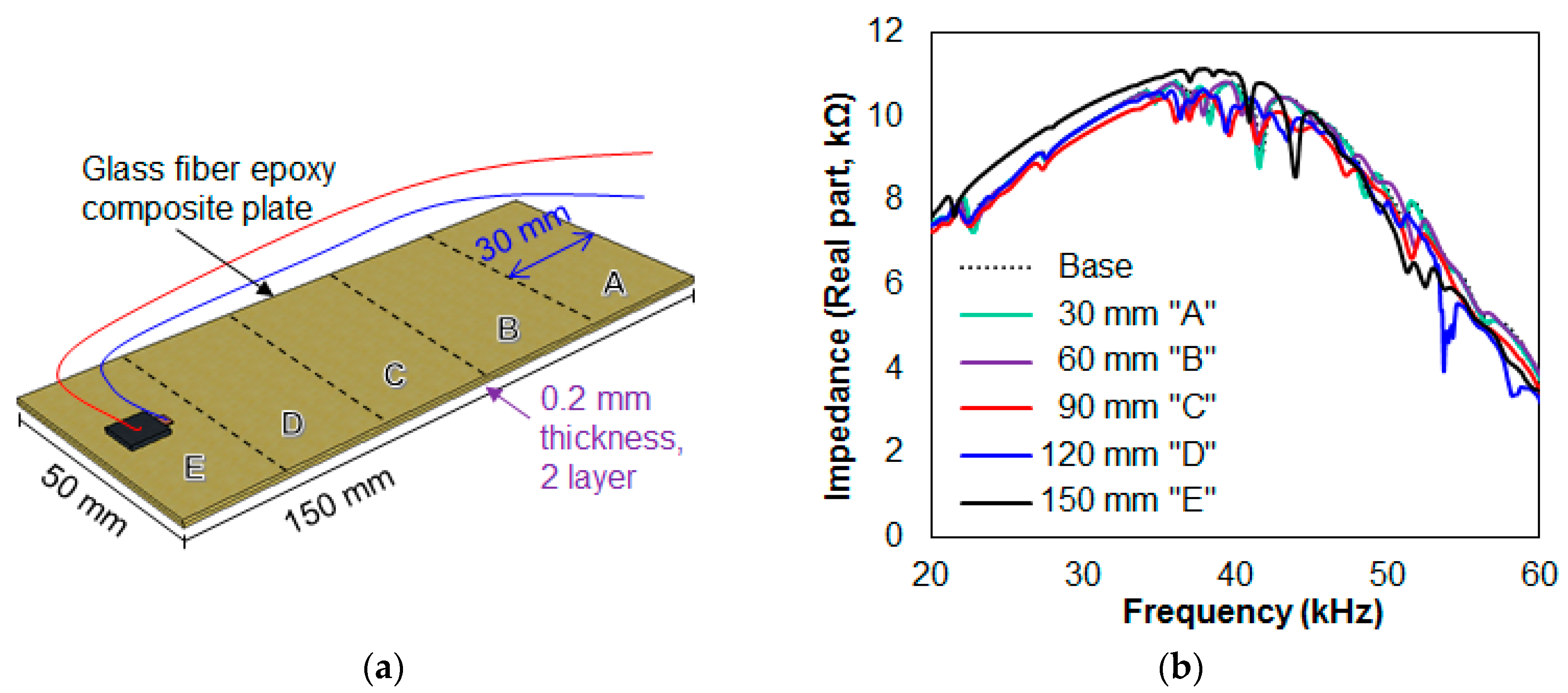
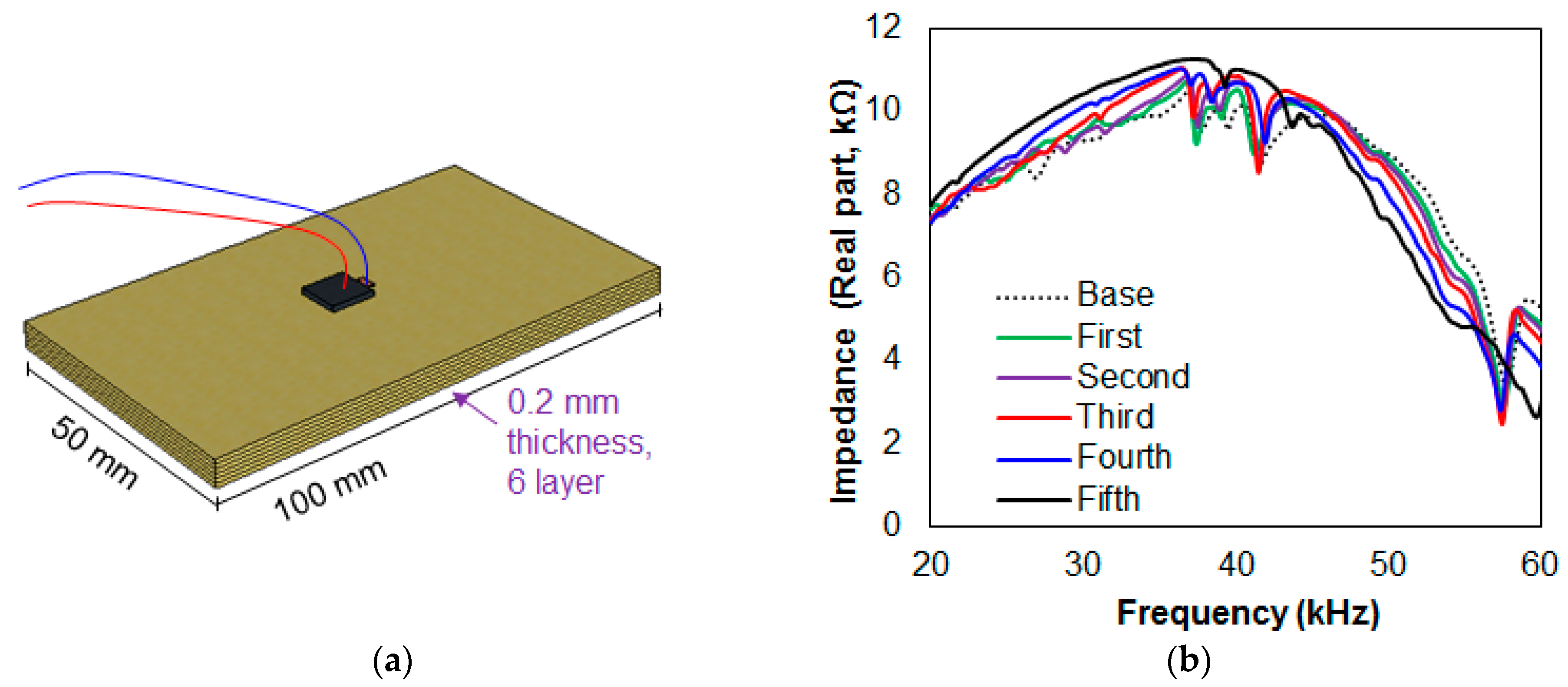


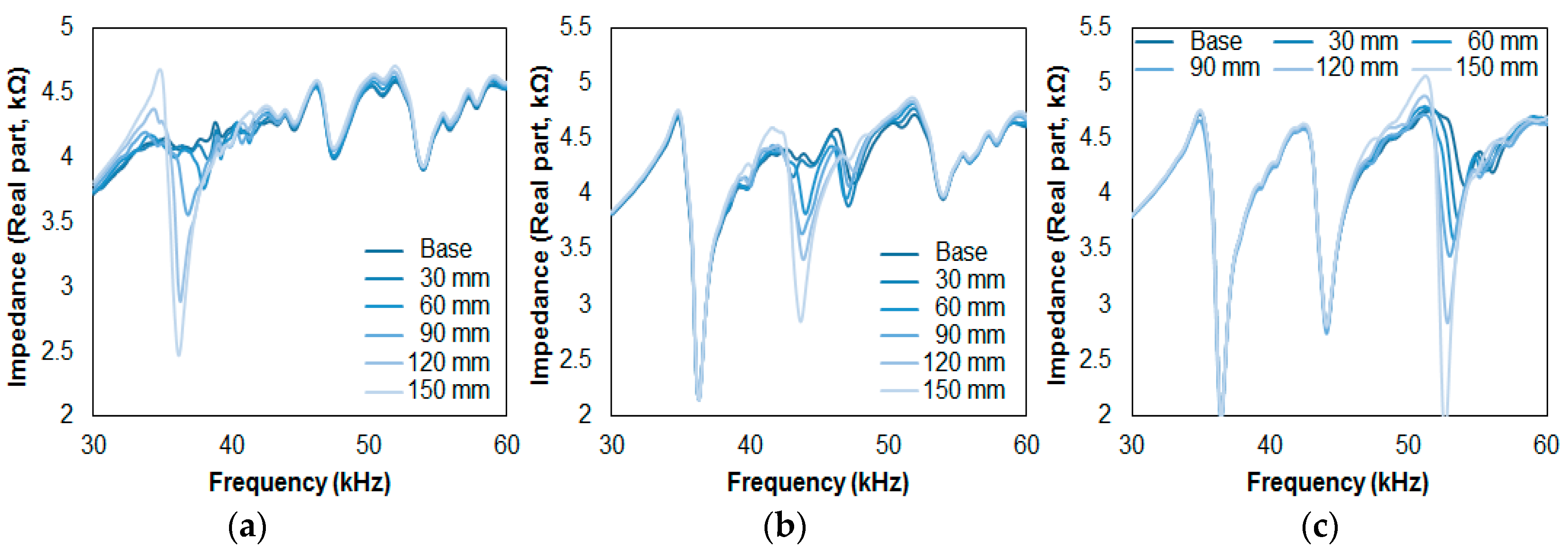
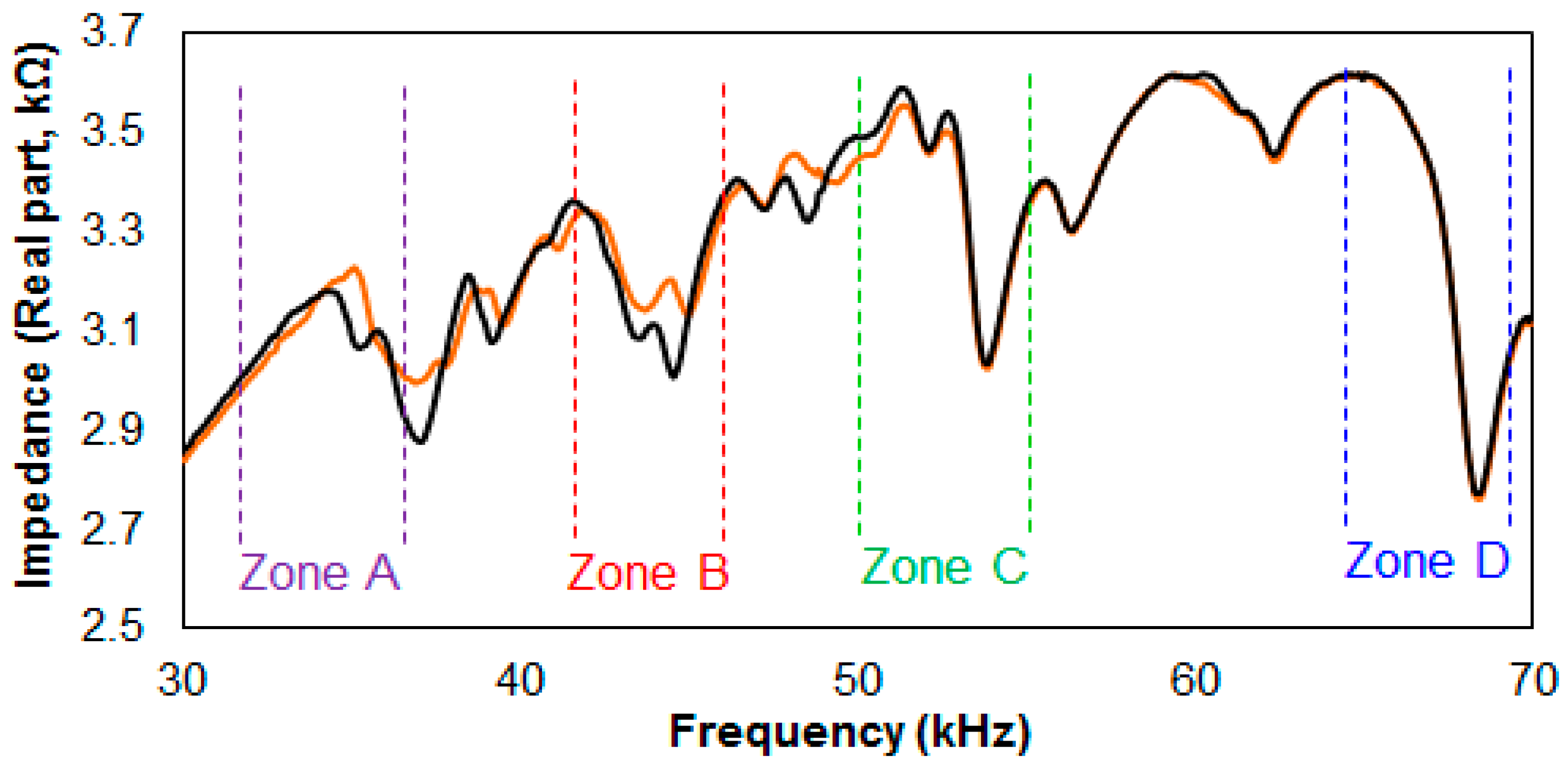
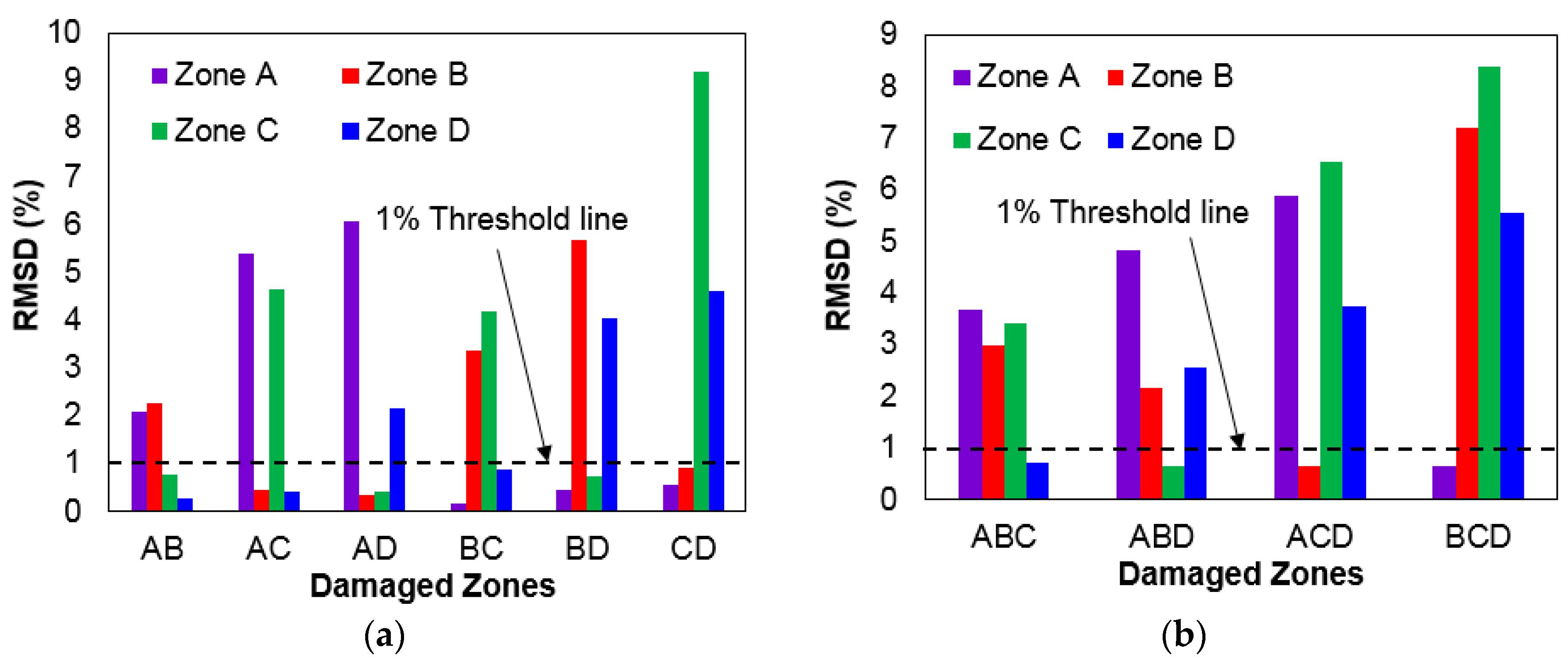
| 30 mm | 60 mm | 90 mm | 120 mm | 150 mm | ||
|---|---|---|---|---|---|---|
| Case 1 | Zone A | 0.56 | 0.51 | 1.73 | 1.58 | 10.23 |
| Zone B | 0.11 | 0.18 | 0.17 | 0.44 | 0.75 | |
| Zone C | 0.16 | 0.21 | 0.30 | 0.41 | 0.59 | |
| Case 2 | Zone A | 0.19 | 0.25 | 0.24 | 0.38 | 0.52 |
| Zone B | 0.49 | 4.54 | 3.15 | 5.41 | 8.81 | |
| Zone C | 0.11 | 0.17 | 0.35 | 0.51 | 0.75 | |
| Case 3 | Zone A | 0.34 | 0.36 | 0.42 | 0.42 | 0.47 |
| Zone B | 0.60 | 0.69 | 0.72 | 0.70 | 0.96 | |
| Zone C | 0.94 | 1.79 | 2.77 | 5.13 | 14.16 |
| First | Second | Third | Fourth | Fifth | ||
|---|---|---|---|---|---|---|
| Case 4 | Zone A | 1.24 | 3.25 | 5.23 | 10.81 | 15.89 |
| Zone B | 0.75 | 1.02 | 0.89 | 1.37 | 1.91 | |
| Zone C | 0.28 | 0.51 | 0.73 | 0.93 | 1.51 | |
| Case 5 | Zone A | 0.36 | 0.72 | 1.04 | 1.37 | 1.80 |
| Zone B | 1.70 | 4.58 | 7.74 | 10.26 | 15.95 | |
| Zone C | 0.52 | 0.77 | 0.72 | 1.08 | 1.36 | |
| Case 6 | Zone A | 0.12 | 0.23 | 0.26 | 0.30 | 0.49 |
| Zone B | 0.21 | 0.53 | 0.54 | 0.66 | 1.15 | |
| Zone C | 4.47 | 7.86 | 10.73 | 15.83 | 23.06 |
© 2017 by the authors. Licensee MDPI, Basel, Switzerland. This article is an open access article distributed under the terms and conditions of the Creative Commons Attribution (CC BY) license (http://creativecommons.org/licenses/by/4.0/).
Share and Cite
Na, W.S.; Baek, J. Adhesive Defect Monitoring of Glass Fiber Epoxy Plate Using an Impedance-Based Non-Destructive Testing Method for Multiple Structures. Sensors 2017, 17, 1439. https://doi.org/10.3390/s17061439
Na WS, Baek J. Adhesive Defect Monitoring of Glass Fiber Epoxy Plate Using an Impedance-Based Non-Destructive Testing Method for Multiple Structures. Sensors. 2017; 17(6):1439. https://doi.org/10.3390/s17061439
Chicago/Turabian StyleNa, Wongi S., and Jongdae Baek. 2017. "Adhesive Defect Monitoring of Glass Fiber Epoxy Plate Using an Impedance-Based Non-Destructive Testing Method for Multiple Structures" Sensors 17, no. 6: 1439. https://doi.org/10.3390/s17061439
APA StyleNa, W. S., & Baek, J. (2017). Adhesive Defect Monitoring of Glass Fiber Epoxy Plate Using an Impedance-Based Non-Destructive Testing Method for Multiple Structures. Sensors, 17(6), 1439. https://doi.org/10.3390/s17061439




